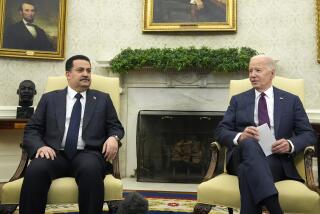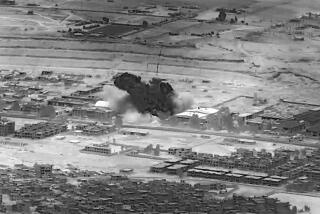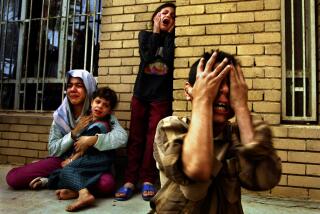U.S. Flexes Its Muscles in Iraq’s North
- Share via
KIRKUK, Iraq — U.S. forces in this northern city bombed a suspected enemy staging area Monday and conducted house-to-house searches as the military continued a nationwide show of force aimed at halting the expansion of the insurgency and capturing its organizers and financiers.
The drive to intimidate the insurgents included the firing of a missile carrying a 500-pound warhead at a target near Tikrit -- the second use of such a weapon in as many days. So far, however, the effect of the firepower is unclear, with the number of attacks on coalition forces holding about steady at 26 in the last 24 hours, a military spokesman said.
Two more U.S. soldiers were killed Monday north of Baghdad, near the city of Balad, one by a roadside bomb and the other by automatic weapons fire. A third died from a nonhostile gunshot wound in Baghdad, the military said.
Balad is within the so-called Sunni Triangle, a hotbed of resistance north and west of Baghdad. Army officers fear that fighters and ringleaders from the region have been moving farther north into the Kirkuk area. Relatively tranquil immediately after the war, Kirkuk has seen a surge of armed attacks lately.
“The direction is coming from down there -- and the money,” said Capt. Joseph Scanlin, an intelligence officer with the 173rd Airborne Brigade, which occupies the Kirkuk area.
Kirkuk, a multiethnic city of Kurds, Turkmens and Arabs, fell to paratroopers from the 173rd without a substantial fight, and attacks on U.S. troops were infrequent through the summer. But there has been a jump in all kinds of attacks over the last two months, including roadside bombs, ambushes, mortar strikes and, most recently, rockets aimed at the Kirkuk air base, where the 173rd is headquartered.
Attacks have also targeted Iraqi police and others whom the opposition views as collaborators. Fliers have circulated here denouncing those who work with the U.S.-backed government as traitors. “We will kill you,” the leaflets warn.
In the last week, a rocket was fired at a police station, and attackers staged a drive-by assault on a police checkpoint with grenades and machine guns, killing one Iraqi lawman. The increasing strikes convinced U.S. commanders that it was time to send a message back.
“The violence that has been happening to U.S. forces in other parts of the country has been migrating here,” said Maj. Robert Cornejo. “As long as we keep the initiative and stay on the offense, we can keep the enemy from making Kirkuk as bad as other parts of Iraq.”
The offensive near Kirkuk, part of a broader operation dubbed Ivy Cyclone II, began Sunday when a missile was fired at a sandy island in the Zaab River, a tributary of the Tigris southwest of here. Officers said Saddam Hussein loyalists had used the isle as a firing range.
U.S. troops subsequently discovered that no one was killed in the strike, and there were no permanent structures on the island to be destroyed. But the strike made a statement, official said.
“We wanted to send a signal that we’ve got our eyes on it,” Scanlin said. “They probably won’t be back there soon.”
Indeed, commanders nationwide have said one aim of their campaign is to let the enemy know that the Army means business and has no intention of cutting and running from Iraq. “It sends a message that we can attack them any time, and we still have a lot of capability in this country,” Cornejo said.
Monday’s attacks in Kirkuk consisted of a bombing and artillery run on a vacant shack south of town in an area identified as a staging zone for attacks on U.S. troops, and a house-to-house search in an Arab neighborhood where anti-U.S. sentiment is strong. The search resulted in 14 detentions, officials said.
“People need to know that if they help the enemy and provide material support and sanctuary to the enemy, they are going to be treated the same as a subversive element,” said Maj. Douglas Vincent. He noted that U.S. forces might have difficulty fighting insurgents coming into Kirkuk from the south because locals wouldn’t know them and couldn’t inform on them.
Communication between groups of insurgents in different parts of the country seems to be accomplished subtly, typically through personal messengers, commanders say.
“The directors coming up here to give guidance or provide money -- they’re smart, they don’t want to expose themselves,” Scanlin said.
Whether the bombing runs, missile strikes and searches in Kirkuk and elsewhere will help smash the resistance or dissuade new recruits from joining remains to be seen.
Residents of the mostly Arab neighborhood near Monday’s bombing in Kirkuk didn’t appear to be intimidated. Many assumed it was a U.S. target-practice exercise and went about their business.
In Baghdad, meanwhile, a U.S. patrol opened fire at a gun market, killing an 11-year-old boy and two other people after apparently mistaking customers’ test-firings as an attack, Associated Press reported.
The capital has been without power for more than 24 hours in the wake of high winds that knocked down two towers that control the flow of electricity. Although the towers were repaired, the line had a short-circuit Sunday and Baghdad remained blacked out early this morning.
In other developments Monday, a militant group calling itself Muhammad’s Army claimed responsibility for downing a U.S. Chinook helicopter Nov. 2, killing 16 soldiers. In a videotape aired on the Lebanese Al Hayat-LBC satellite channel, the group warned that U.S. forces would face more attacks if they did not leave Iraq in 15 days. The group also said it was behind the recent assassination of a member of the Iraqi Governing Council.
In Washington, meanwhile, the CIA said the latest audio message purportedly from Hussein can’t be authenticated. The quality of the recording is too poor for the agency’s analysts to reach any conclusions, a spokesman said.
*
Times staff writer Alissa J. Rubin in Baghdad contributed to this report.
More to Read
Sign up for Essential California
The most important California stories and recommendations in your inbox every morning.
You may occasionally receive promotional content from the Los Angeles Times.













